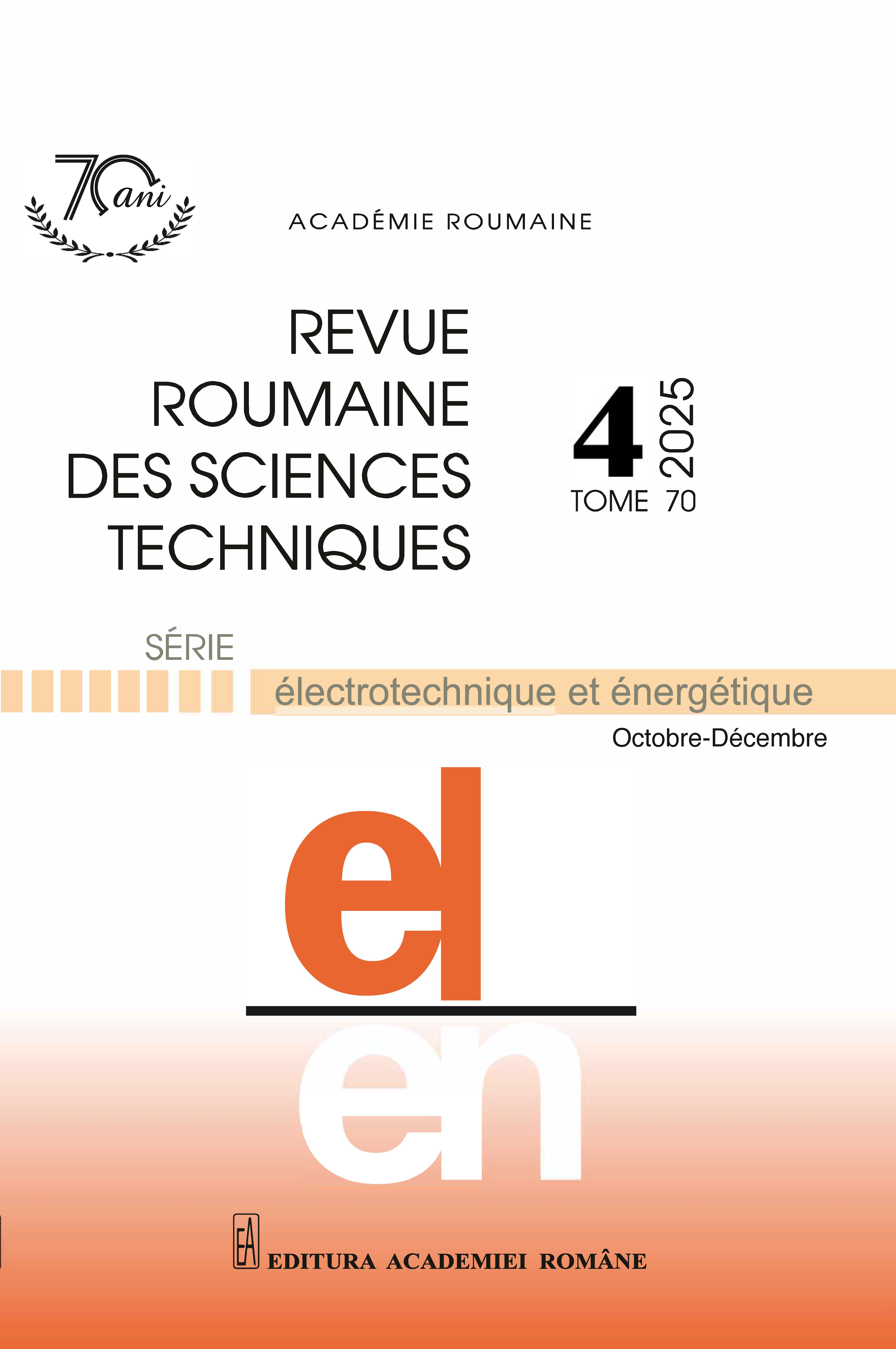PERFORMANCES DE DÉSEXCITATION DYNAMIQUE DES MACHINES SYNCHRONES SANS BALAIS UTILISANT UNE STRATÉGIE DE COMMANDE AVANCÉE
DOI :
https://doi.org/10.59277/RRST-EE.2025.4.12Mots-clés :
Générateur synchrone, Excitation sans balais, Régulation de tension, Contrôle H∞, Contrôleur à logique floueRésumé
Les générateurs synchrones (SG) sont des convertisseurs électromécaniques essentiels largement utilisés dans les centrales électriques, où un contrôle précis de l'excitation est crucial pour maintenir la régulation et la stabilité de la tension. La principale limitation du système d'excitation sans balais conventionnel (CBE) est son incapacité à fournir des tensions négatives à l'enroulement de champ, ce qui limite la désexcitation rapide en cas de rejet soudain de la charge et provoque des dépassements de tension aux bornes. Pour remédier à ce problème, cet article propose un système avancé d'excitation sans balais flou (FABE) intégrant un contrôle logique flou (FLC) et un contrôle H∞ afin d'améliorer les performances transitoires et en régime permanent des générateurs synchrones. Le contrôleur H∞ garantit la robustesse face aux perturbations, aux incertitudes des paramètres et aux non-linéarités, tandis que le FLC améliore l'adaptabilité et la réponse dynamique. L'approche hybride proposée permet une désexcitation plus rapide, une réduction des pics de tension et un meilleur amortissement des oscillations. Les résultats de la simulation démontrent que le système FABE surpasse nettement la méthode d'excitation conventionnelle en termes de stabilité de tension, de réponse dynamique et de performances globales de contrôle, dans diverses conditions de fonctionnement.
Références
(1) C.H.T. Lee, K.T. Chau, C. Liu, and C.C. Chan, Overview of magnetless brushless machines, IET Electric Power Appl., 12, pp. 1117–1125 (2018).
(2) C.A. Platero, M. Redondo, F. Blázquez, and P. Frías, High-speed de-excitation system for brushless synchronous machines, IET Elect. Power Appl., 6, pp. 156–161 (2012).
(3) E. Rebollo, C.A. Platero, D. Talavera, and R. Granizo, Use of discharge resistor to improve transient de-excitation in brushless synchronous machines, Energies, 12, 13, pp. 2528 (2019).
(4) E. Rebollo and C.A. Platero, Wireless supervision of a rotating high-speed de-excitation system for brushless SM, In International Conference on Electrical Machines (ICEM), Chalmers in Sweden (2020).
(5) S.E. Chouaba and A. Barakat, Advanced brushless excitation system with dynamic de-excitation capability, International Review of Electrical Engineering, 14, 2, pp. 1636 (2019).
(6) S.E. Chouaba and A. Barakat, Controlled brushless de-excitation structure for synchronous generators, Eng. Technol. Appl. Sci. Res., 9, 3, pp. 4218–4224 (2019).
(7) G.M. Ngaleu, A novel brushless de‐excitation system for synchronous generators using a buck chopper with a freewheeling discharge resistor, IET Electr. Power Appl., 17, 3, pp. 314–329 (2023).
(8) J.K. Nøland, E.F. Alves, A. Pardini, and U. Lundin, Unified reduced model for a dual-control scheme of the high-speed response brushless excitation system of synchronous generators, IEEE Trans. on Industrial Electronics, 67, 6, pp. 4474–4484 (2020).
(9) O.K. Krinah, R. Lalaloul, Z. Ahmida, and S. Oudina, Performance investigation of a wind power system based on double-feed induction generator: fuzzy versus proportional integral controllers, Rev. Roum. Sci. Techn. – Électrotechn. Et Énerg., 67, 4 (2022).
(10) A. Derbane, B. Tabbache, and A. Ahrichea, Fuzzy logic approach based direct torque control and five-leg voltage source inverter for electric vehicle powertrain, Rev. Roum. Sci. Techn. – Électrotechn. Et Énerg., 66, 1, pp. 15–20 (2021).
(11) A. Akka, H. Lallouani, O. Moussa, and A. Bouzidi, Interval type-2 fuzzy logic control for brushless doubly fed induction generator based on wind energy conversion systems, Rev. Roum. Sci. Techn. – Électrotechn. Et Énerg., 70, 3, pp. 307–311 (2025).
(12) C. Mama, A. Chaouch, and B. Benaissa, Comparison of the various controls of the switched reluctance motor 12/8, Rev. Roum. Sci. Techn. – Électrotechn. Et Énerg., 68, 1, pp. 52–57 (2023).
(13) Kentli, Studies on fuzzy logic control of electrical machines in Turkish Universities: an overview, Mathematical and Computational Applications, 16, 1, pp. 236–247 (2011).
(14) Hazzab, A. Laoufi, I.K. Bousserhane, and M. Rahli, Real-time implementation of fuzzy gain scheduling of PI controller for induction machine control, International Journal of Applied Engineering Research, 1, 1, pp. 51–60 (2006).
(15) Khelloufi, B. Sari, and S.E. Chouaba, Structured H∞ control-based robust power system stabilizer for stability of multi-machine system, Rev. Roum. Sci. Techn. – Électrotechn. Et Énerg., 69, 1, pp. 91–96 (2024).
(16) Barakat, S. Tnani, G. Champenois, and E. Mouni, Monovariable and multivariable voltage regulator design for a synchronous generator modeled with fixed and variable loads, IEEE Trans. Energy Convers., 26, 3, pp. 811–821 (2011).
(17) R.W. Beaven, M.T. Wright, and D.R. Seaward, Weighting function selection in the H∞ design process, Control Eng. Practice, 4, 5, pp. 625–633 (1996).
(18) D.W. Gu, P.H. Petkov, and M.M. Konstantinov, Robust control design with MATLAB, Springer, New York (2005).
Téléchargements
Publiée
Numéro
Rubrique
Licence
(c) Copyright REVUE ROUMAINE DES SCIENCES TECHNIQUES — SÉRIE ÉLECTROTECHNIQUE ET ÉNERGÉTIQUE 2025

Ce travail est disponible sous licence Creative Commons Attribution - Pas d'Utilisation Commerciale - Pas de Modification 4.0 International.


